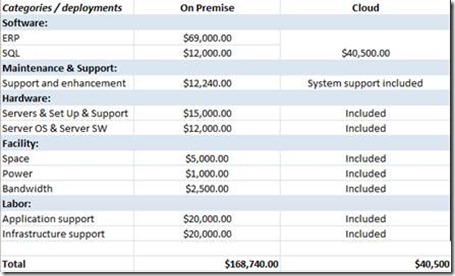Kati Unplugged: Cloud Total Cost of Ownership Means “Do More with Less”
A Blog Series for Microsoft Dynamics Partners by Kati Hvidtfeldt, US Microsoft Dynamics ERP Cloud Lead.
 It is no secret that cost is one of the key considerations that moves customers to the cloud. The concept of Total Cost of Ownership (TCO) involves not only up-front investment and ongoing maintenance costs, but brings time-to-value into the equation. This week Bob Pederson, Microsoft Dynamics Partner Technology Adviser, takes a comparative look at the costs of on-premise and cloud-based deployment models, and offers an example of a how new offering from Microsoft Dynamics partner Merit Solutions delivers a compelling TCO story to prospective customers.
It is no secret that cost is one of the key considerations that moves customers to the cloud. The concept of Total Cost of Ownership (TCO) involves not only up-front investment and ongoing maintenance costs, but brings time-to-value into the equation. This week Bob Pederson, Microsoft Dynamics Partner Technology Adviser, takes a comparative look at the costs of on-premise and cloud-based deployment models, and offers an example of a how new offering from Microsoft Dynamics partner Merit Solutions delivers a compelling TCO story to prospective customers.
_______________________________________
Why are customers buying cloud solutions? The word on the street is the main driver is cost: the lower price point to get started and lower price point ongoing. Cost is the first thing customers notice, and why wouldn’t they? You can rent Microsoft Dynamics at around $200USD monthly per user. Stack that up against the costs of an on-premise solution, including funding an IT staff and buying the ERP, network and database software plus the hardware and communications infrastructure. Then add in the cost of ongoing software support and you have a built a compelling case in support of the lower-cost cloud model.
If you do the math (okay I will) the tab for an on premise solution based on 20 Enterprise users comes to just under $170K the first year. At that rate the investment in an on-premise ERP solution will equal the cumulative annual cost of the cloud solution in a little over four years. If you consider that the cloud solution can also allow customers to reduce IT FTE staff (two half-time FTEs at a salary of $40,000 each), the on-premise investment eclipses the cloud number in less than three years. I would argue that leveraging the advantage of reducing IT staff with a cloud solution has to be part of the equation. Email me at rpederso@microsoft.com if you think I’m wildly off any of these numbers.
One example of a solution that offers competitive cloud-based TCO is MAXCloud, an exciting new offering for Microsoft Dynamics AX from Microsoft Dynamics partner Merit Solutions. According to Josh Richards, Merit’s marketing program manager, “We priced our solution at $225USD per user for vanilla Microsoft Dynamics AX but customers can really leverage a solution when they add one of our industry applications. Merit took all their years in the pharmaceutical and food space, developed IP for these, and now offers them on top of MAXCloud.”
Quick time-to-value is a good barometer of the effectiveness of a SaaS solution, and Merit delivers here as well. Time-to-value has 2 dimensions: how fast Merit can get the system implemented and how quickly users can be fully productive. Merit offers a 30-day fixed bid for implementation called “Rapid On Fixed Priced Package Services.” Say THAT 10 times quickly. If I am a CIO, Merit just made my job easier when I pitch this to the board of directors.
To learn more about how to incorporate cloud-based solutions into your business plans visit the Microsoft Dynamics Countdown to the Cloud page on PartnerSource. Go to www.microsoft.com/dynamics/growyourbusiness for resources that demonstrate to customers how

